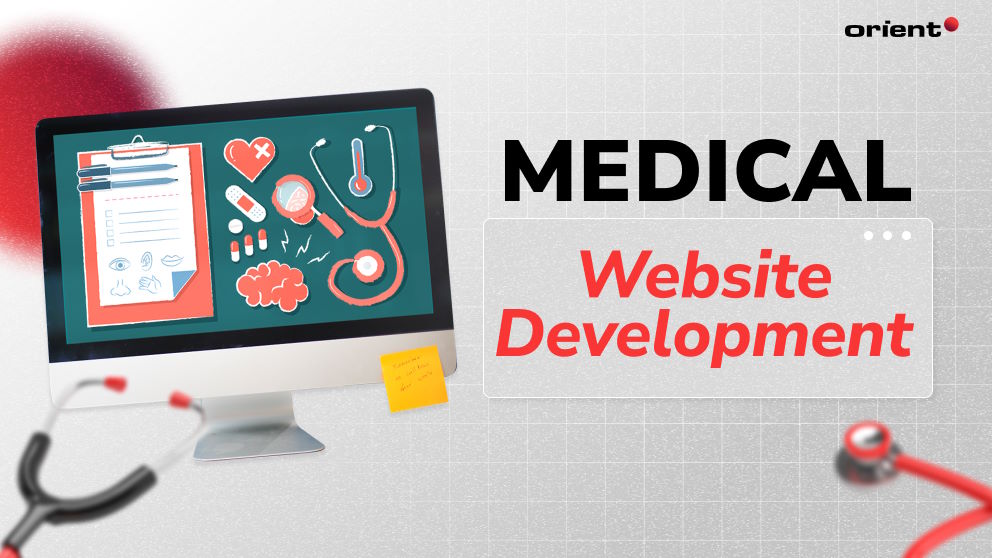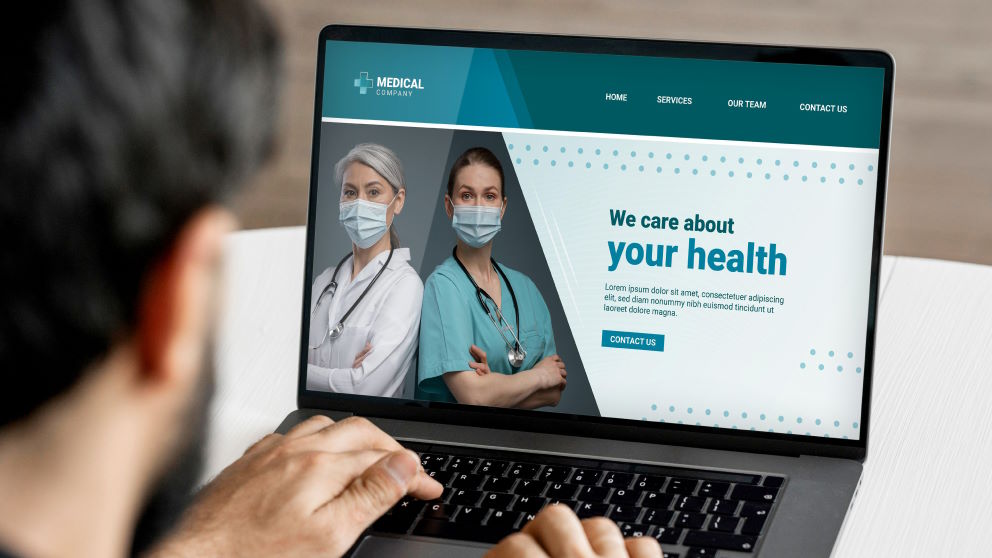Medical Website Development: What You Need to Know to Build the Best Websites

Content Map
More chaptersNo search engine, chatbot, or artificial intelligence can replace a doctor. Even so, when someone has questions about their health, they will most likely go online and search for some form of answer to their question.
This is why a medical website’s first impression matters. Not only do first impressions drive more visitors to your website, but your clinic is also made known to a wider public.
Building a medical website isn’t as complicated as brain surgery, but it definitely isn’t a walk in the park, either. It gets confusing when you try to pinpoint the essential elements for a successful healthcare website since there are so many ways to go about this matter. If you are experiencing this confusion, this article is for you. Read on to find the concise guide to the best medical website development.
Why Do You Need to Care About Medical Website Development?

A medical website can be seen as an extension of your medical practice. Everything, from what healthcare services you have available to blog posts that inform your visitors, should be included on the website. In short, a web page demonstrates your role as a medical practitioner and how you care for the patients who visit your practice.
In addition to representing your practice, there are a myriad of merits in investing in medical web development.
Accessibility
Not only does a website increase your establishment’s credibility, but it also gives clients quick and easy access to essential information like your locations, operation hours, services you offer, updates and announcements, and so on. Users can also go to your website to look for quality information on specific health problems and diseases before reaching their phone and calling your staff.
Digital Marketing
Medical websites are a great way to grow your business. If you are looking to attract more traffic to a landing page or a website, examine your historical traffic, have a better view of your target audience, and maximize the ROI on your ads.
Establish Your Credibility and Brand
It is likely that there are other health facilities that offer the same services as you do. If you wish to stand out and prove your legitimacy to those who haven’t heard of you, it’s time to get your pen and paper and start working on that medical website design. If you already have a website and it hasn’t been updated in a long time, get yourself a team of healthcare website developers to update the user interface and upload some quality information.
Key Features of a Medical Website Design

There seem to be endless possibilities in regard to designing medical websites. It is tempting to have your healthcare web development team integrate the newest and trendiest technological features. However, before we move on to any of the fancy functions, make sure you have the essential features of the website down first.
Include the Basic Information About Your Healthcare Facility
You wouldn’t want your staff to constantly answer calls about the clinics’ or hospitals’ locations and operation hours, would you? Make sure to have this essential information on the homepage. Your users should have no trouble finding this information on your website.
Additionally, if you have multiple locations for your health establishment, have the website suggest your clients with the nearest locations.
List Your Services
Similar to the previous feature, it would be extremely time-consuming to receive numerous calls a day and note every single service available. Instead, your website should place the services at a visible location, e.g., at the top of the page. Website visitors should be able to click on each service and look through it for more information. In the case of special or unique services, make sure you have your team highlight them somehow.
Provide Customers with Information About Your Team of Healthcare Professionals
In order to gain your customer’s trust, provide users with further information about your healthcare providers. What does their background look like? What are their specialties? This also enhances your team’s credibility and gains your customer’s trust.
Make Booking an Appointment as Easy as Possible
Many find booking an appointment with a doctor a hassle. Therefore, your website should make this process as easy as possible. The option to schedule, modify, or cancel appointments online is cited by 68% of patients as a factor in their decision to choose a medical practitioner. Hence, don’t let potential clients slip away just because your website doesn’t provide online booking options.
Have your team of medical website developers give users the option to choose the date, time, and doctors while also filling in crucial information like their names, insurance, and symptoms.
Don’t Forget the Search Bar
Presenting only the most basic information on the website can be a lot to navigate through. Therefore, ensure customer satisfaction with a search bar with filters so they can quickly find what they need.
Other Advanced Features
After you have implemented the above-mentioned features well, there are other advanced features to consider, including:
- Chatbots: The medical industry has embraced chatbots for a while now. They are a great choice for answering after-hours questions, especially those involving basic information.
- Online Payments: Some hospitals have applications in which patients can pay online. This can be done via different methods like PayPal, Apple Pay, Samsung Pay, etc. Do keep in mind, however, the potential security problems that come along with it.
- Online Consultation: Telemedicine has grown rapidly recently. Hospitals have utilized video consultations to accommodate the elderly or those who don’t have assistance from friends or family.
- Feedback: Patients can leave feedback about their experience. This feedback enhances your reputation as well as helps you improve service to enhance customer satisfaction.
What Makes a Great Medical Website?
In addition to having all the key features during medical web design, what else do you need to create a great medical website? There are, of course, many factors, but we have compiled a list of criteria that you should pay extra attention to.
Regulation Compliance
Having an up-to-date medical website is impressive, but keep in mind there are strict regulations you need to follow. There is no one-size-fits-all solution, however. For example:
- If you are working on healthcare website development in the USA, you need to comply with HIPPA (Health Insurance Portability and Accountability Act) and HITECH (Health Information Technology for Economic and Clinical Health) to keep your protected health information (PHI) data safe.
- If you are based in Canada and working on your medical web design, you need to keep PIPEDA (The Personal Information Protection and Electronic Documents Act) in mind.
- European developers need to pay attention to the GDPR (General Data Protection Regulation).
Regulation and law compliance can be complex at times. Therefore, it is best to consult with a professional medical web development company with industry expertise, like Orient Software, to gain the best results.
A Comprehensive Privacy Policy
Since healthcare industry websites work with a lot of sensitive and confidential data, you need to have a comprehensive privacy policy in place. The privacy policy should provide information regarding the location of the data and how it will be safeguarded against security risks. It should explain the duration of the data retention and how the data will be securely erased after a specified period of time or upon the request of a customer. Additionally, the opt-out policy should be included.
Quick Load Speed and SSL Certificate
With an SSL (secure sockets layer) certificate, the conversations that people and businesses have with your website are kept private. In addition to fostering customer trust, it increases your website’s security, verifies your identity, safeguards your data, keeps you safe from hackers, minimizes downtime, and boosts your search engine rankings.
In this day and age, your medical practice website needs to be safe and fast. A 2019 study by Portent indicated that the ideally acceptable page loading time is in the range of 0 and 4 seconds, with the first five seconds having the greatest effects on conversion rates. Make sure your healthcare web development partner keeps in mind these factors so your website stands out.
Mobile Friendly
Hitwise has reported that 68% of health-related searches are conducted on mobile phones. Since people almost always have their phones with them, you cannot neglect the mobile users while building the website. Make sure it is mobile-friendly - which means its size will automatically adjust to whatever mobile device it is on. Most users get frustrated viewing a website on a smartphone or tablet and constantly pinching and dragging. It is likely that they will just exit the website altogether.
Hence, make sure to check with your medical clinic website development team if the web is friendly with mobile devices.
Valuable Content and Strong Images
A robust website, in addition to a great medical practice website development team, also has a strong content team onboard. Sharing insightful blog posts, frequently asked health questions, and having a section for patient reviews would definitely encourage those who are familiar with your clinic to come back and visit the site often. As for new visitors, quality content creates a strong first impression and even generates new leads. Furthermore, valuable content enhances brand awareness and increases the chances of ranking high on Google pages.
Amazing content is quality text as well as strong imagery. It is strongly advised that you include images of you and your staff instead of posting some random stock photos. Personalized images are highly appreciated and demonstrate that your practice or hospital is genuine and approachable.
How Much Does Medical Web Development Cost?

It is hard to state the exact cost of a project without knowing the specifics, but the cost range of building a medical website is anywhere from $5,000 to $100,000. There are many factors that affect this number. If you are looking to build a healthcare corporate website, the average cost is $5,000. If you want to build a hospital management website, however, the average cost is $80,000. If you hire experienced healthcare web developers from the UK, the average budget is $170,000, but if you look for a medical web design company in South Asia, the cost falls around $40,000.
However, this is not the only factor to consider. The cost will vary depending on whether the project is being developed by a local agency, an offshore development center, a WordPress-based website, or a more complex solution with multiple components.
There are endless possibilities for building a medical web. Take your budget into consideration before embarking on this journey. This is why we suggest a consultation session with seasoned experts to get the most accurate estimated price. Come to us for online medical website design services and more. Orient Software team doesn’t provide you with a fixed price - we will spend time talking and getting to know your requirements and visions, analyzing them, and then providing you with the best solution. Contact us today if you would like to know more.







